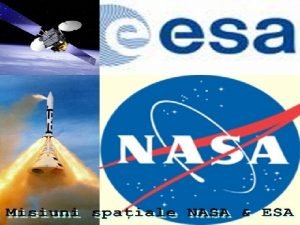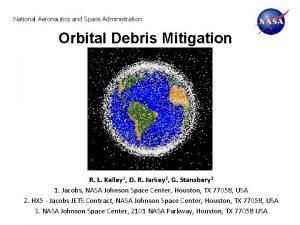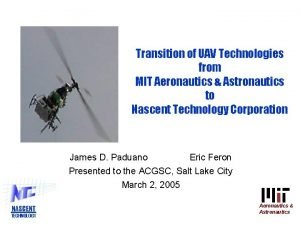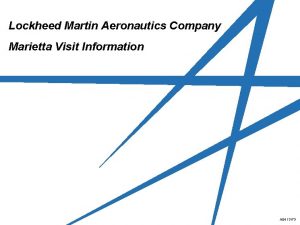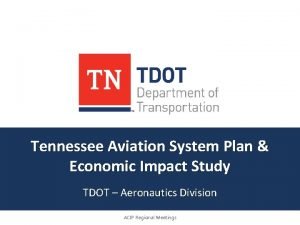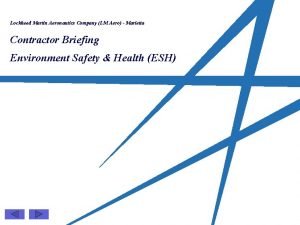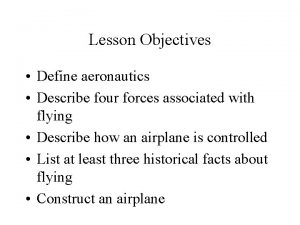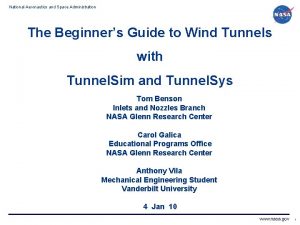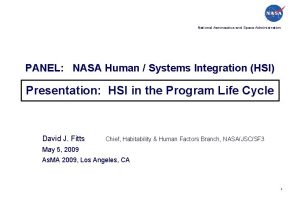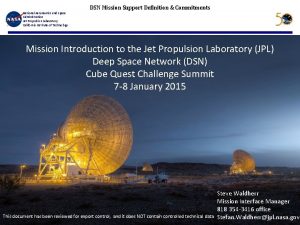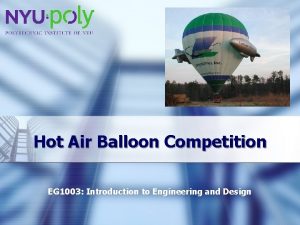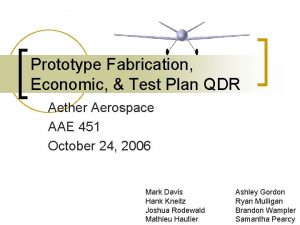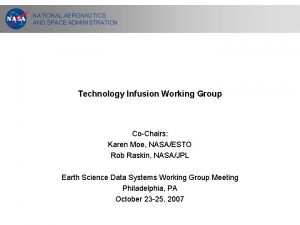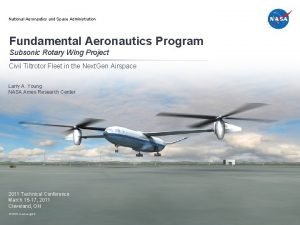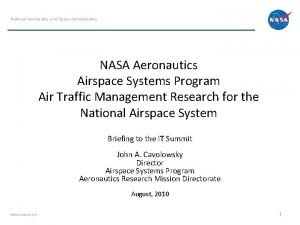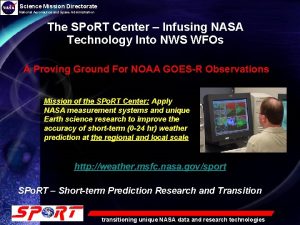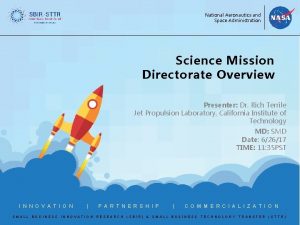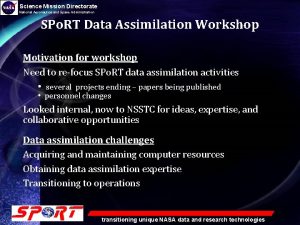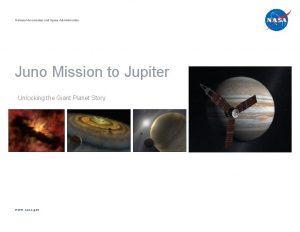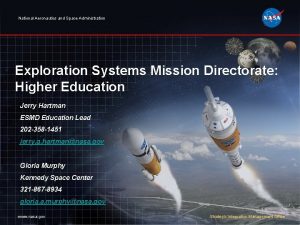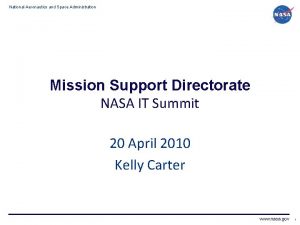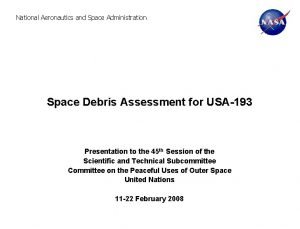National Aeronautics and Space Administration HIAD Mission Infusion













- Slides: 13

National Aeronautics and Space Administration HIAD Mission Infusion: Technology Development & Potential Utilization Dr. F. Mc. Neil Cheatwood Stephen Hughes Dr. Anthony Calomino NASA Langley Research Center IPPW-12 Presentation June 16, 2015

What is a HIAD? A Hypersonic Inflatable Aerodynamic Decelerator (HIAD) is a deployable aeroshell consisting of an Inflatable Structure (IS) that maintains shape during atmospheric flight, and a Flexible Thermal Protection System (F-TPS) employed to protect the entry vehicle through hypersonic atmospheric entry. 2

Background: Why a HIAD? Entry mass at Mars (and other destinations with atmospheres) is limited by launch vehicle shroud size. u At Mars, increased capability needed for higher mass and/or higher altitude, eventual human missions. u Inflatable technologies allow larger aeroshell to be stowed inside launch shroud. u ü Inflation of Inflatable Structure (IS) occurs prior to atmospheric entry. ü Flexible Thermal Protection System (F-TPS) protects IS and payload from entry environments. u NASA La. RC has been developing Inflatable Aeroshell technology for over 10 years. 3

HIAD Technology Development Cadence u Systematic and stepwise technology advancement ü Ground Test: Project to Advance Inflatable Decelerators for Atmospheric Entry (PAI-DAE)—Softgoods technology breakthrough ü Flight Test: Inflatable Reentry Vehicle Experiment (IRVE), 2007: LV anomaly—no experiment ü Flight Test: IRVE-II, 2009—IRVE “build-to-print” re-flight; first successful HIAD flight ü Ground Test: HIAD Project improving structural and thermal system performance (Gen-1 & Gen-2)—Extensive work on entire aeroshell assembly ü Flight Test: IRVE-3, 2012—Improved (Gen-1) 3 m IS & FTPS, higher energy reentry; first controlled lift entry u Next Steps Ground Effort: Gen-3 F-TPS, advanced structures, packing, manufacturability at scale >10 m, controllability, and demonstrated staging to secondary decelerator. Prepares for large-scale flight test and readiness for Mars mission. Flight Test Possibilities: United Launch Alliance (ULA) flight test and/or booster recovery at scale and environments relevant to Mars Human EDL Pathfinder. 4

Flexible TPS Inflatable Structure HIAD Ground-Based Development To Date Manufacturing Testing Performance Modeling • Define large-scale fabrication methods • Optimize packed volume and density requirements • Establish manufacturing processes and quality control standards • Quantify aerodynamic structural response • Verify load reaction and structural integrity • Establish structural performance limits • Qualify structural materials performance capability • Establish handling and stowage requirement • Define design methods and safety margins • Validate non-linear structural modeling capability • Establish structural design procedures and standards • Define system weight, stiffness, and strength options Torus Stacking and Alignment Torus Compression/ Torsion Tests • Establish large-scale fabrication methods • Define manufacturing processes and quality control standards • Determine handling and stowage requirements • Characterize mechanical and thermal physical properties • Define mission-cycle performance capability • Establish F-TPS material performance limits Fabrication Stagnation Static Loading • Extend F-TPS materials performance capability • Qualify thermal and aeroelastic response • Define system integration metrics and requirements Dynamic Response • Validate a multi-physics thermal response model • Establish design requirements and safety margins • Verify integrated system load response Structural Contribution Multi-Physics Model

IRVE-3: A Fully Successful Flight Test Apogee 366 s, 474 km Aeroshell Release 429 s, 457 km Start Aeroshell Inflation 433 s, 455 km Check out the video at: http: //youtu. be/7 JGa. Ov. C 1 s. V 4 Coast… ACS Reorientation 587 s, 266 km (40 s duration) Eject Nose Cone 102 s, 177 km NIACS damps rates 91 s, 152 km (10 s duration) Separate RV & Nose Cone From Brant & Transition 90 s, 152 km Yo-Yo De-Spin, 80. 0 s Brant Burnout, 56. 9 s Brant Ignition, 23. 0 s Taurus Separation 21. 0 s Taurus Burnout, 18. 5 s Taurus Ignition, 15. 0 s Talos Burnout, 6. 4 s Spin Motor Ignition, 0. 9 s Leaves Rail, 0. 5 s Talos Ignition, 0 s Launch on Black Brant-XI from WFF 940 lb payload, El 84 deg, Az 155 deg Actuate CG offset system 628 s, 181 km (1 s duration) Atmospheric Interface, 25 Pa (666 s, ~86 km) RV Peak Heat Rate 14 -17 W/cm 2 680 s, 50 km, Mach 7 (peak Mach 10. 2) RV Peak Dynamic Pressure 685 s, 41 km, 20. 8 g’s Reentry Experiment Complete at Mach < 0. 7 (709 s, 27 km) CG Offset Maneuvers LOS by land radar & TM 12 -29 km altitude Vent NIACS and Inflation System Gas RV splashdown at 30 m/s 383 km downrange (1193 s) Recovery Attempt 6

THOR: The One That Got Away… 7

Potential HIAD Mission Infusion u Robotic missions to any destination with an atmosphere (including sample return to Earth) u High mass delivery to high altitudes at Mars (including humans to Mars) u Lower cost access to space through launch vehicle asset recovery (for example, ULA’s booster module) u ISS down mass (without Shuttle, the U. S. has no large-scale down mass capability) 8

Evolvable Mars Campaign – Capability & Mission Extensibility Mars EDL Pathfinder 70+ MT SLS 105+ MT SLS Staying Exploration Augmentation Module Space Station ace EDL / Lander Asteroid Redirect Vehicle Capabiliti es International Surf Advanced Propulsion Healthy 130+ MT SLS Tra Long Duration Habitat nsp ort Wo rkin g In atio Long Duration Surface Systems n Spa ce ISRU All Paths Through Mars Orbit EM-X Crewed Missions in Cis -lunar space Mars 2020 Asteroid Proving Ground Missions to Redirect Robotic Returned Asteroid & EAM for Mission Mars risk reduction ISS Deep Space & Mars Risk Reduction Missions Deep Space Mars Preparation Mars Moon First Human Mission to Long Duration Human 9

Evolvable Mars Campaign – Capability & Mission Extensibility Mars EDL Pathfinder 70+ MT SLS 105+ MT SLS Staying Exploration Augmentation Module Space Station ace EDL / Lander Asteroid Redirect Vehicle Capabiliti es International Surf Advanced Propulsion Healthy 130+ MT SLS Tra Long Duration Habitat nsp ort Wo rkin g In atio Long Duration Surface Systems n Spa ce ISRU HIAD Future Path Development Activity Ground-Based Efforts All Paths Through Mars Orbit Performance EM-X Crewed Missions in Cis -lunar space Asteroid Redirect Robotic Scalability Mars 2020 Mission ISS Deep Space & Mars Risk Reduction Controllability Missions Staging from HIAD Human Precursor Mission at Mars Proving Ground Missions to Returned Asteroid & EAM for Mars risk reduction Flight Deep Space Mars Preparation Testing Mars Moon First Human Mission to Long Duration Human 10

ULA’s Planned Utilization of a HIAD Image courtesy ULA 11

Development Path for 2024 Mars Demo, Utilizing ULA 14 15 16 17 18 19 20 21 22 23 24 25 26 Full-Scale Capability Pathfinder PDR CDR Launch EDL Architecture Study IRVE-3 HIAD Gen-1 complete “HIAD-2” (ground-based) Project Gen-2 & Gen-3 15 m-class HIAD ½-Scale Orbital Flight Test Gen-2 6 m-class IRVE-S Sounding Rocket Flight Test effort Ground Test effort Earth flight test Cascade Decelerator HIAD Full-Scale Orbital Flight Test Gen-2/3 12 m-class TBD Launch ULA Infusion 12

HIAD Similitude IRVE-3 Scale TPS ½-Scale Demo Full-Scale Centaur Recovery ULA Booster Recovery Mars 2024 EDL Pathfinder 5 -6 m 10 -12 m Si. C 3 X carbon felt Pyrogel Si. C 5 X carbon felt 3 X carbon felt Pyrogel Parafoil & Recover of Device(s) X Cascade Decelerator X Similar Con. Ops X X X 13
 National aeronautics and space administration
National aeronautics and space administration National aeronautics and space administration, u.s.a.
National aeronautics and space administration, u.s.a. Mit aeronautics and astronautics
Mit aeronautics and astronautics Pioneer astronautics internship
Pioneer astronautics internship Tools of aeronautics
Tools of aeronautics Lockheed martin slogan
Lockheed martin slogan Tdot aeronautics
Tdot aeronautics Lm aero
Lm aero Define:aeronautics
Define:aeronautics Beginner's guide to aeronautics
Beginner's guide to aeronautics Hsi
Hsi Aeronautics definition
Aeronautics definition Part of hot air balloon
Part of hot air balloon Aether aeronautics
Aether aeronautics
